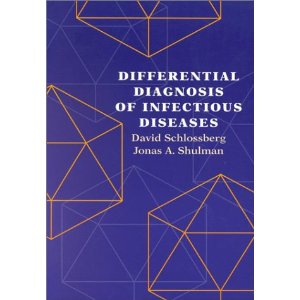Differential Diagnosis of Infectious Diseases (1996) by
David Schlossberg MD is one of those rare let-me-try-to-tell-you-in-350-pages-or-less-everything-I’ve-ever-learned-in-a-lifetime-of-clinical-practice types of medical books.
Unlike most microbiology and infectious diseases books, which are organized on the basis of bugs or diseases, Differential Diagnosis is arranged on the basis of specific clinical problems or chief complaints (fever, pneumonitis, diarrhea, rash, arthritis or lymphadenopathy). This is a superior arrangement because it reflects the way in which clinicians approach problems in the real world.
The book helps the reader tease apart various pathogens on the basis of the patient history and physical examination. Classic associations (tularemia with rabbits, psittacosis with birds, etc.) are all listed in tables, as are the important clinical signs and diagnostic methods for the more bread-and-butter bugs. Finally, and perhaps most importantly, the book contains entries which alert the reader about noninfectious diseases that can mimic infectious diseases. For example, the author lists eosinophilic pneumonia and pulmonary embolism as possible mimickers of acute infectious pneumonitis. This reinforces the important concept that every doctor, even a specialist, is a generalist first and needs to be aware of diagnostic possibilities that, technically speaking, could be considered to fall outside to the province of his or her specialty.
“a well-developed knowledge of clinical microbiology is critical for the practicing physician in any medical field. Bacteria, viruses, and protozoans have no respect for the distinction between ophthalmology, pediatrics, trauma surgery, or geriatric medicine. Microbiology is one of the few courses where much of the ‘minutia’ is regularly used by the practicing physician.”
Mark Gladwin MD, Clinical Microbiology Made Ridiculously Simple (2011), preface
Thus, I recommend Differential Diagnosis of Infectious Diseases very highly to anyone who is interested in any aspect of medicine. In particular, medical students and residents would greatly benefit from this book.



Leave a Reply